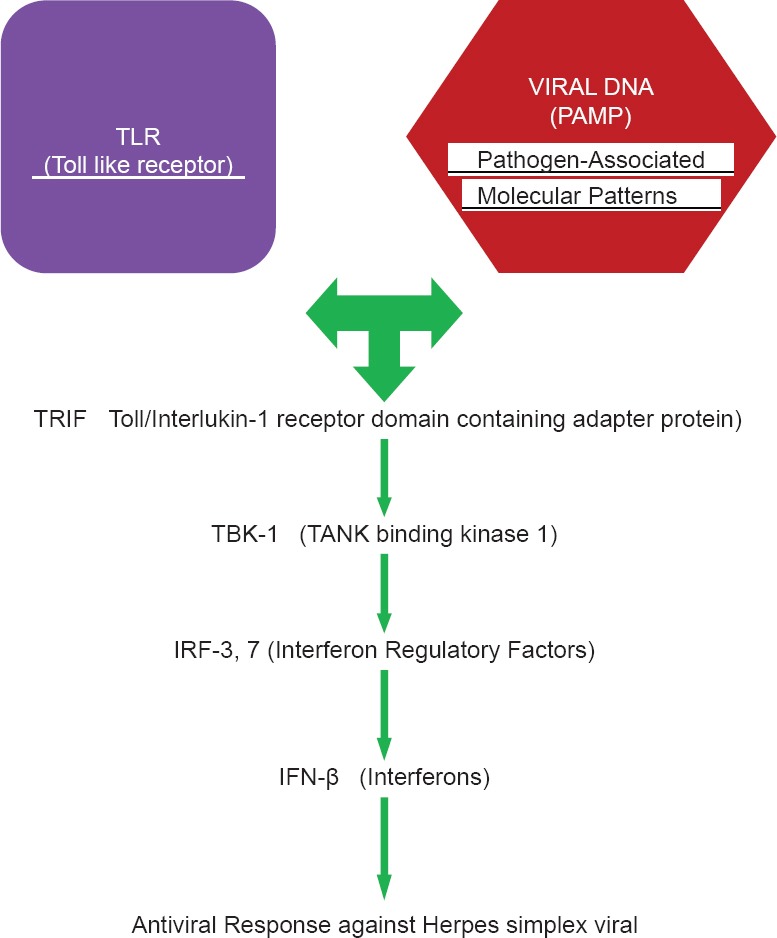Sir,
In recent times, significant developments have been made in understanding the mechanisms involved in initial host recognition to viral infections, and how this viral recognition leads to the immune response. The viral recognition is mediated by pattern recognition receptors (PRR), which are a primeval part of the immune system. PRR is the protein expressed by cells of the innate immune system to identify highly conserved structural motifs known as pathogen-associated molecular patterns (PAMP). PAMP are exclusively expressed by microorganisms which include viral double-stranded RNA and various bacterial cell wall components such as lipopolysaccharide, and bacterial DNA.
Toll like receptors (TLR) are the most eminent members of the PRR. TLR owe their names to a famous Drosophila gene, Toll (in German Toll, means super or fantastic).[1] Ten human TLRs (TLR1 to TLR10) have been characterized so far. TLR is a type I transmembrane protein characterized by an extracellular domain containing leucine-rich repeats and a cytoplasmic extension that contains a conserved region called the Toll/interleukin-1 receptor domain. TLR is located on the plasma membrane with the exception of TLR3, TLR7, and TLR9 which are localized in the endosomal compartment. TLR are mainly expressed in tissues involved in immune function, such as spleen and peripheral blood leukocytes. Their expression profiles vary between tissues and cell types.
Toll like receptors recognition with their corresponding PAMP triggers two distinct pathways: A MyD88-dependent pathway that leads to the production of inflammatory cytokines, and MyD88-independent pathway associated with the stimulation of interferons-β (IFN).
Herpes simplex viral (HSV) double stranded RNA is recognized by the endosomal TLR. After binding to its cognate, TLR activates the adapter protein, toll/interlukin-1 receptor domain containing adapter protein (TRIF), in a MyD88-independent pathway. TRIF combines with a protein kinase TBK1 (TANK binding kinase 1) to produce interferon regulatory factors (IRF 3 and IRF 7) which subsequently produces IFN-β, resulting in antiviral activity [Figure 1].[2] There are yet other receptors in the cytoplasm called RLR (retinoic acid inducible gene, RIG like receptors) which also recognize the viral RNA and work together with TLR in the production of IFN-β.
Figure 1.

Schema for toll like receptors recognition of herpes simplex viral - pathogen-associated molecular patterns and its signalling cascade
However, HSV has a unique way to evade this anti-viral IFN-β response by producing serine protease NS3/4A (degrades the cellular adapter protein TRIF) and immediate early protein ICP0 (prevents the aggregation of activated IRF-3).[3]
Clinical and virological manifestations of genital HSV-2 infections vary widely due to the single-nucleotide polymorphisms in TLR. Studies proved that polymorphisms in TLR 2 had resulted in increased HSV-2 genital shedding. Svensson et al. in their study suggested that the absence of TLR3 functional activity predisposes children to HSV-1 encephalitis.[4] Apart from genetic variations in TLR which modify the course of HSV illness, Resiquimod, a TLR 7 and TLR 8 agonist also decreases HSV-2 genital shedding.[5]
Thus, the critical role played by TLR in innate immunity has been a tremendous advancement in the pathogenesis of HSV infection and more treatment options could be tried in this line.
REFERENCES
- 1.Chtarbanova S, Imler JL. Microbial sensing by Toll receptors: A historical perspective. Arterioscler Thromb Vasc Biol. 2011;31:1734–8. doi: 10.1161/ATVBAHA.108.179523. [DOI] [PubMed] [Google Scholar]
- 2.Han KJ, Su X, Xu LG, Bin LH, Zhang J, Shu HB. Mechanisms of the TRIF-induced interferon-stimulated response element and NF-kappaB activation and apoptosis pathways. J Biol Chem. 2004;279:15652–61. doi: 10.1074/jbc.M311629200. [DOI] [PubMed] [Google Scholar]
- 3.Lemen SM, Sparling PF. Pathogenesis of sexually transmitted viral and bacterial infections. In: Holmes K, Sparling PF, Stamm WE, editors. Sexually Transmitted Diseases. 4th ed. New Delhi: The McGraw Hill Companies; 2008. p. 314. [Google Scholar]
- 4.Svensson A, Tunbäck P, Nordström I, Padyukov L, Eriksson K. Polymorphisms in Toll-like receptor 3 confer natural resistance to human herpes simplex virus type 2 infection. J Gen Virol. 2012;93:1717–24. doi: 10.1099/vir.0.042572-0. [DOI] [PubMed] [Google Scholar]
- 5.Mark KE, Corey L, Meng TC, Magaret AS, Huang ML, Selke S, et al. Topical resiquimod 0.01% gel decreases herpes simplex virus type 2 genital shedding: A randomized, controlled trial. J Infect Dis. 2007;195:1324–31. doi: 10.1086/513276. [DOI] [PubMed] [Google Scholar]


